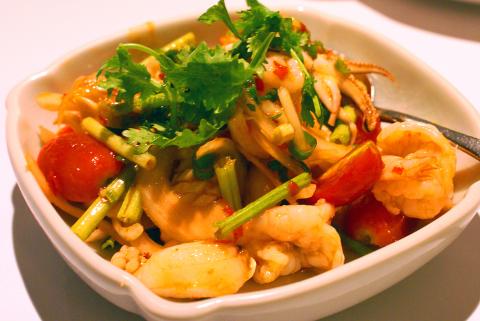Walking out on to the seventh floor of Building A9 of Xinyi Shin Kong Mitsukoshi (新光三越), we are met with the fragrance of lemon grass and coconut milk, the smell immediately drawing our attention towards Thai Town and its set lunch menu on a lectern at the restaurant’s entrance. At first glance, our party of three is astounded: NT$630 for three. We only later did we find out that the price is actually NT$630 per person. It’s still worth it.
Thai Town has seven locations throughout Taipei as well as branches in Taipei County, Taichung and Kaohsiung (www.thaitown.com.tw). The management boasts that it maintains strict control over the training of its staff and the quality of its ingredients so that what you get at one location is of comparable quality at another. I cannot vouch for the other locations, but our party was heartily satisfied with the meal we were served.
The tastefully finished interior of faux wood walls and floors punctuated here and there with trees had immediate appeal. Floor to ceiling windows offer glimpses of passing shoppers loaded down with bags of newly bought goods.

Photo: Noah Buchan, Taipei Times
We ordered the six-course lunch, which includes a choice of shrimp pancake, Thai seafood salad, beef stir-fry, chicken curry, fried vegetables, dessert and a drink. A la carte prices are in brackets.
Our drinks arrived first. Long strips of fresh coconut floated in the slightly sweet coconut juice (NT$90), while the iced tea (NT$90), with its generous addition of lemon, was sour enough to pucker the face.
The spicy Thai seafood salad (NT$300) and spicy shrimp pancake (NT$320) came next. The slightly salty pancake, which featured chunks of baby shrimp nestled between a crispy exterior, went well with the piquant and slightly lemony marinade of the salad, which was topped by generous portions of fresh crab, shrimp and cuttlefish. This Thai salad was a crowd favorite, our table competing for the last morsel, and left us panting for more.
The main course was a trifecta of different flavors. First came the beef stir-fry, a Massaman curry (NT$300). Tender slices of beef, chunks of green pepper and onion floated in a spicy-sweet curry sauce and covered with swaths of coconut cream topped with needles of lemon grass.
The decadence continued with a green curry chicken in coconut sauce (NT$280). Subtle flavors of basil and lemongrass were discernable through the sweet coconut milk. The fried water convolvulus with shrimp paste (NT$180) was the meal’s only miss because of the addition of dried shrimp, which made an already salty dish saltier. We left most of it on the plate.
But then came dessert: black sticky rice (NT$95) served hot with taro in coconut milk and ice. Thai Town’s interpretation of this dessert, with its chewy warm rice and taro contrasting with the sweet coconut, ranks as one of the best I’ve tried in Taipei.

June 9 to June 15 A photo of two men riding trendy high-wheel Penny-Farthing bicycles past a Qing Dynasty gate aptly captures the essence of Taipei in 1897 — a newly colonized city on the cusp of great change. The Japanese began making significant modifications to the cityscape in 1899, tearing down Qing-era structures, widening boulevards and installing Western-style infrastructure and buildings. The photographer, Minosuke Imamura, only spent a year in Taiwan as a cartographer for the governor-general’s office, but he left behind a treasure trove of 130 images showing life at the onset of Japanese rule, spanning July 1897 to

In an interview posted online by United Daily News (UDN) on May 26, current Chinese Nationalist Party (KMT) Chairman Eric Chu (朱立倫) was asked about Taichung Mayor Lu Shiow-yen (盧秀燕) replacing him as party chair. Though not yet officially running, by the customs of Taiwan politics, Lu has been signalling she is both running for party chair and to be the party’s 2028 presidential candidate. She told an international media outlet that she was considering a run. She also gave a speech in Keelung on national priorities and foreign affairs. For details, see the May 23 edition of this column,

At Computex 2025, Nvidia CEO Jensen Huang (黃仁勳) urged the government to subsidize AI. “All schools in Taiwan must integrate AI into their curricula,” he declared. A few months earlier, he said, “If I were a student today, I’d immediately start using tools like ChatGPT, Gemini Pro and Grok to learn, write and accelerate my thinking.” Huang sees the AI-bullet train leaving the station. And as one of its drivers, he’s worried about youth not getting on board — bad for their careers, and bad for his workforce. As a semiconductor supply-chain powerhouse and AI hub wannabe, Taiwan is seeing

Jade Mountain (玉山) — Taiwan’s highest peak — is the ultimate goal for those attempting a through-hike of the Mountains to Sea National Greenway (山海圳國家綠道), and that’s precisely where we’re headed in this final installment of a quartet of articles covering the Greenway. Picking up the trail at the Tsou tribal villages of Dabang and Tefuye, it’s worth stocking up on provisions before setting off, since — aside from the scant offerings available on the mountain’s Dongpu Lodge (東埔山莊) and Paiyun Lodge’s (排雲山莊) meal service — there’s nowhere to get food from here on out. TEFUYE HISTORIC TRAIL The journey recommences with